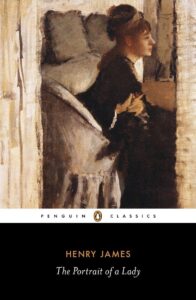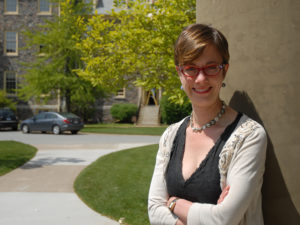Each month, we ask a member of faculty to tell us about one book that played an outsized role in making them who they are today. This month, Professor of Theatre Roberta Barker shares the impact her Words to Live By have had on her life.
What book have you chosen?
 The Portrait of a Lady by Henry James.
The Portrait of a Lady by Henry James.
When did you first read this book?
I started it–unforgettably for me–on a bus on the way from Calgary to Red Deer as part of a chamber choir trip in 1990, when I was a 16-year-old student at Western Canada High School.
Was it a book that you read quickly or did you take your time reading it?
I absolutely devoured it! I remember reading it under the desk in my high school German class, covered by the German textbook. This is probably one reason why my German continues to be terrible.
What was it about the book that first stood out to you?
 From the first time I read The Portrait of a Lady, I adored its complicated, psychologically nuanced characters, whose surface wit and charm conceal many layers of hidden motivation and unacknowledged longing. I loved the glamorous locales of the novel, all set in places I had never been but longed to go: the lawns and rooms of the Touchetts’ English country house, the street and hills of Florence, the Osmonds’ beautiful but tomb-like Roman palazzo. And like so many others, I found James’s heroine, Isabel Archer—that vivid, brilliant, tragically wrongheaded “young woman affronting her destiny”—an irresistible, maddening and fascinating figure.
From the first time I read The Portrait of a Lady, I adored its complicated, psychologically nuanced characters, whose surface wit and charm conceal many layers of hidden motivation and unacknowledged longing. I loved the glamorous locales of the novel, all set in places I had never been but longed to go: the lawns and rooms of the Touchetts’ English country house, the street and hills of Florence, the Osmonds’ beautiful but tomb-like Roman palazzo. And like so many others, I found James’s heroine, Isabel Archer—that vivid, brilliant, tragically wrongheaded “young woman affronting her destiny”—an irresistible, maddening and fascinating figure.
Have you reread this book? If so, did you get something different from it on rereading?
I have reread it many times over the past thirty years, have listened to many audiobook and radio versions of it, and have watched every film and theatrical adaptation of it I could. Basically, I am a compulsive re-visitor of The Portrait of a Lady. The more I return to it as an adult, the more I perceive it as a novel about the process of growing up: about coming to terms with one’s own flaws and limitations, the complications of real human relationships, the consequences of one’s mistakes, the failure of one’s ideals and mortality itself. As a young woman, I read it as a novel about a young woman. I now perceive it as a novel about the loss of youthful illusions—and the possibility that self-worth, integrity and dignity can lie on the other side of that loss.
How did this book shape you?
I think James’s people—especially Isabel, her cousin Ralph Touchett and her frenemy Serena Merle—were the first literary characters I ever encountered who found pleasure and meaning in exploring the complexities, contradictions, unexpected beauties and hidden horrors of other human beings’ personalities. It seems ludicrous to say that I, a very ordinary Calgary high-schooler, discovered anything at all of myself in these clever, elegant members of 19th-century Euro-American high society. But the impulse to understand the rich and strange inner lives of other human beings, which James articulates with great nuance and insight through these characters, would eventually be one of the key forces that got me interested in theatre. “Try to be one of the people on whom nothing is lost!” James famously declared in his essay, “The Art of Fiction.” Long before I read that essay, The Portrait of a Lady offered me the same invitation. I’ve generally failed in the task, but it’s been an inspiration, nevertheless.
What do you think it is about this book that made such an impact?
At a pivotal point in The Portrait of a Lady, Ralph Touchett answers his father’s question, “What do you mean by rich?” by saying, “I call people rich when they’re able to meet the requirements of their imagination.” At the heart of the book, for me, is James’s vision of the imagination as a tremendously powerful force that can bring illumination, love, and joy, but also utter catastrophe. The novel both celebrates imagination and warns against the self-delusions it can carry in its train. Thanks to the power of James’s own remarkable imagination, this vision impressed me even as a teenaged first-time reader of The Portrait of a Lady, and it has stayed with me ever since.
Who do you think should read this book?
Henry James is a bit like marmite; for most of my friends and acquaintances, he is either a favorite or a writer they loathe. So, I wouldn’t want to force this book on anyone. But speaking as one of its lovers, I would enthusiastically recommend The Portrait of a Lady to any reader who wants to travel into the labyrinth of the human heart with one of the all-time masters of labyrinthine prose. And for young people on the cusp of life, especially, it offers an invitation to plunge into the world of other people—and a warning about the beautiful and terrible complications that will likely greet them when they do.

